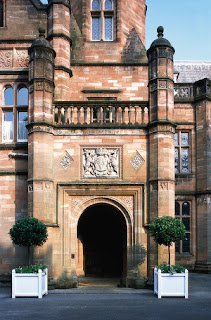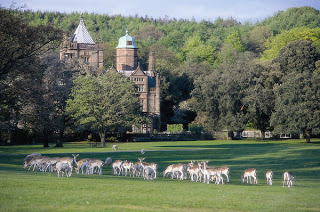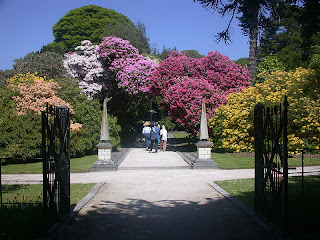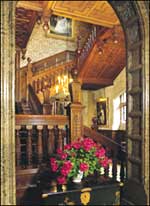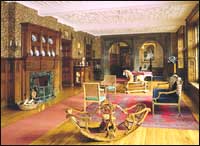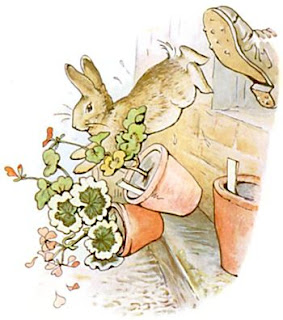Oh, the shark, babe, has such teeth, dear
And it shows them pearly white
Just a jackknife has old MacHeath, babe
And he keeps it … ah … out of sight.
Ya know when that shark bites, with his teeth, babe
Scarlet billows start to spread
Fancy gloves, though, wears old MacHeath, babe
So there’s nevah, nevah a trace of red.
Now on the sidewalk … uuh, huh … whoo … sunny mornin’ … uuh, huh
Lies a body just oozin’ life … eeek!
And someone’s sneakin’ ‘round the corner
Could that someone be Mack the Knife?
Don’t you love Mack the Knife? I do. I’ve added Bobby Darin’s version of the song to nearly every cd I’ve burned. Imagine my surprise when I learned that Mack the Knife has it’s roots in England . . . . . The character of Macheath, later to become Mack the Knife, first appeared in The Beggar’s Opera by John Gay (1685-1732). The Beggar’s Opera, a comic ballad opera, took London by storm with it’s portrayal of the lower-class criminals satirizing the government and upper-class society. The main character of The Beggar’s Opera is a swashbuckling thief called Macheath who is polite to the people he robs, shuns violence, and shows impeccable good manners while cheating on his wife. The character is usually understood as partly a satire of Sir Robert Walpole, a leading British politician of the time. The Beggar’s Opera was a success from its first production in 1728, and continued to be performed for many years. It was the first musical play produced in colonial New York and legend has it that George Washington enjoyed it very much.

The Beggar’s Opera by Hogarth
The play was so popular that it prompted Hogarth to fashion a painting upon it. Here is the description of the above painting from the Tate Britain website: “Between 1728 and 1731 Hogarth painted numerous versions of a climactic scene from John Gay’s The Beggar’s Opera, the great theatrical sensation of the period. Hogarth concentrated on a scene set in Newgate prison in which the play’s leading character, a condemned highwayman called Captain Macheath, is shown at the centre of a tug-of-love. The characters of Lucy Lockit and Polly Peachum, both of whom believe themselves married to Macheath, plead with their fathers – respectively a corrupt prison-warden and a crooked lawyer – to set him free. In both versions of A Beggar’s Opera displayed here, Hogarth included the stage trappings and protagonists of the theatrical environment in which Gay’s work was first staged. An elaborate curtain hangs over the proceedings, and Hogarth paints recognisable portraits of such actors as Lavinia Fenton (dressed in white), who famously played Polly Peachum. Furthermore, Hogarth depicts the most fashionable members of the theatre audience sitting on the stage, as was commonplace at this time.”
But back to the song . . . . . the much covered popular tune (Armstrong, Fitzgerald, Darin, Sinatra, Buble, et al) was composed by Kurt Weill with lyrics by Bertolt Brecht for their music drama Die Dreigroschenoper, or, as it is known in English, The Threepenny Opera – based on The Beggar’s Opera. It premiered in Berlin in 1928 and the song became a popular standard. “Mack the Knife” was introduced to the United States hit parade by Louis Armstrong in 1956, but the song is most closely associated with Bobby Darin, who recorded the song in 1958 and won Record of the Year in 1959.
Aah … I said Jenny Diver … whoa … Sukey Tawdry
Look out to Miss Lotte Lenya and old Lucy Brown
Yes, that line forms on the right, babe
Now that Macky’s back in town …
Kurt Weill’s widow, Lotte Lenya, was the star of both the original 1928 German production and the 1954 Blitzstein Broadway version and she happened to be present in the studio during Armstrong’s recording. He spontaneously added her name to the lyrics, which already named several of Macheath’s female victims. All the other women’s names, Suky Tawdry, Jenny Diver, Lucy Brown, etc., appear in the original German version.
You can watch a classic video of Bobby Darin singing Mack The Knife here.
 Of course, some of that had to do with the famous wet shirt scene, at which one might swoon — over what Jane Austen would have made of it!!
Of course, some of that had to do with the famous wet shirt scene, at which one might swoon — over what Jane Austen would have made of it!! 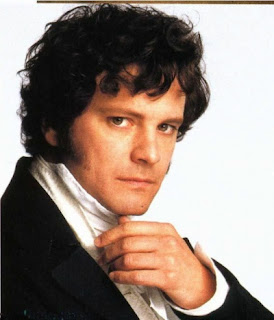 But it also had to do with the smoky, sexy looks Darcy cast Elizabeth’s way — sigh! Talk about “fine eyes.” Firth made an excellent Darcy, looking suitably grim and bored at the beginning, and changing over the six episodes to recognize his love for Lizzy. This did not preclude his continued arrogance and his reluctance to share the real story of Mr. Wickham. But in the end, was anyone in doubt of the happy- ever-after ending? Not I.
But it also had to do with the smoky, sexy looks Darcy cast Elizabeth’s way — sigh! Talk about “fine eyes.” Firth made an excellent Darcy, looking suitably grim and bored at the beginning, and changing over the six episodes to recognize his love for Lizzy. This did not preclude his continued arrogance and his reluctance to share the real story of Mr. Wickham. But in the end, was anyone in doubt of the happy- ever-after ending? Not I.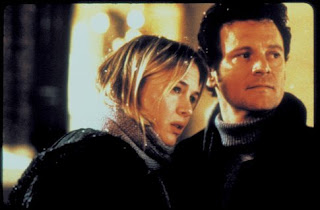 Firth did a sort of reprise of his P and P role when he played Mark Darcy in the Bridget Jones movies in 2001 and 2004.
Firth did a sort of reprise of his P and P role when he played Mark Darcy in the Bridget Jones movies in 2001 and 2004. Colin Firth was born September 10th, 1960, in Grayshott, Hampshire. He lived in Nigeria during part of his childhood later spent a year in the U.S. as a teen. He studied acting at the Drama Centre and was “discovered” while playing Hamlet.
Colin Firth was born September 10th, 1960, in Grayshott, Hampshire. He lived in Nigeria during part of his childhood later spent a year in the U.S. as a teen. He studied acting at the Drama Centre and was “discovered” while playing Hamlet. Firth has appeared on the stage in London but has kept very busy with films, such as the role of the artist Vermeer in The Girl with the Pearl Earring (2003). He appeared in Valmont (1989), The English Patient (1996), Shakespeare in Love (1998), and Love, Actually (2003), among many more.
Firth has appeared on the stage in London but has kept very busy with films, such as the role of the artist Vermeer in The Girl with the Pearl Earring (2003). He appeared in Valmont (1989), The English Patient (1996), Shakespeare in Love (1998), and Love, Actually (2003), among many more. Firth has worked with many fine actresses, none better than Judi Dench in Shakespeare in Love. Kristen Scott Thomas, Jennifer Ehle, Meg Tilly, Renee Zellweger, Isabella Rossellini, and Emma Thompson, to name a few more.
Firth has worked with many fine actresses, none better than Judi Dench in Shakespeare in Love. Kristen Scott Thomas, Jennifer Ehle, Meg Tilly, Renee Zellweger, Isabella Rossellini, and Emma Thompson, to name a few more. If I had been advising Colin Firth on his choice of roles, I guess I would have nixed Mamma Mia (2008). Perhaps they had a great time filming it. Or working with Meryl Streep was impossible to give up. Although Colin’s singing was just fine, Pierce Brosnan was dreadful. But that last scene with all of them dressed in those shiny suits fro the 70’s and parading across the stage made me howl with laughter.
If I had been advising Colin Firth on his choice of roles, I guess I would have nixed Mamma Mia (2008). Perhaps they had a great time filming it. Or working with Meryl Streep was impossible to give up. Although Colin’s singing was just fine, Pierce Brosnan was dreadful. But that last scene with all of them dressed in those shiny suits fro the 70’s and parading across the stage made me howl with laughter.  Firth received international kudos for his role in A Single Man (2009), including the BAFTA, an Oscar nomination, and awards from the Venice International Film Festival. In the role of Professor George Falconer, he mourns the death of his long-time companion.
Firth received international kudos for his role in A Single Man (2009), including the BAFTA, an Oscar nomination, and awards from the Venice International Film Festival. In the role of Professor George Falconer, he mourns the death of his long-time companion. In the meantime, A Single Man has been released on DVD. Colin Firth’s performance is truly excellent. His co-star is Julianne Moore who is also very good, much better than in her usual roles.
In the meantime, A Single Man has been released on DVD. Colin Firth’s performance is truly excellent. His co-star is Julianne Moore who is also very good, much better than in her usual roles.  Among Firth’s upcoming films is his starring role as King George VI in The King’s Speech, co-starring Geoffrey Rush as the coach who helped the King, father of the current Queen Elizabeth II, overcome his stammer. It should be released later in 2010.
Among Firth’s upcoming films is his starring role as King George VI in The King’s Speech, co-starring Geoffrey Rush as the coach who helped the King, father of the current Queen Elizabeth II, overcome his stammer. It should be released later in 2010.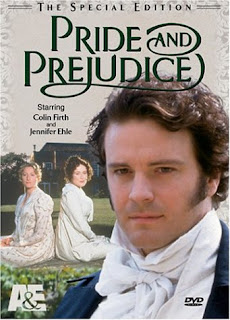 I am sure that Colin Firth will continue to engage us with his portrayals on stage, screen and television, into his middle age. And aren’t we lucky that we all can own a copy of Pride and Prejudice to watch whenever we like? In fact, you can watch a damp Firth in the “lake scene” from Pride and Predjudice here. And the marriage proposal here.
I am sure that Colin Firth will continue to engage us with his portrayals on stage, screen and television, into his middle age. And aren’t we lucky that we all can own a copy of Pride and Prejudice to watch whenever we like? In fact, you can watch a damp Firth in the “lake scene” from Pride and Predjudice here. And the marriage proposal here. 




